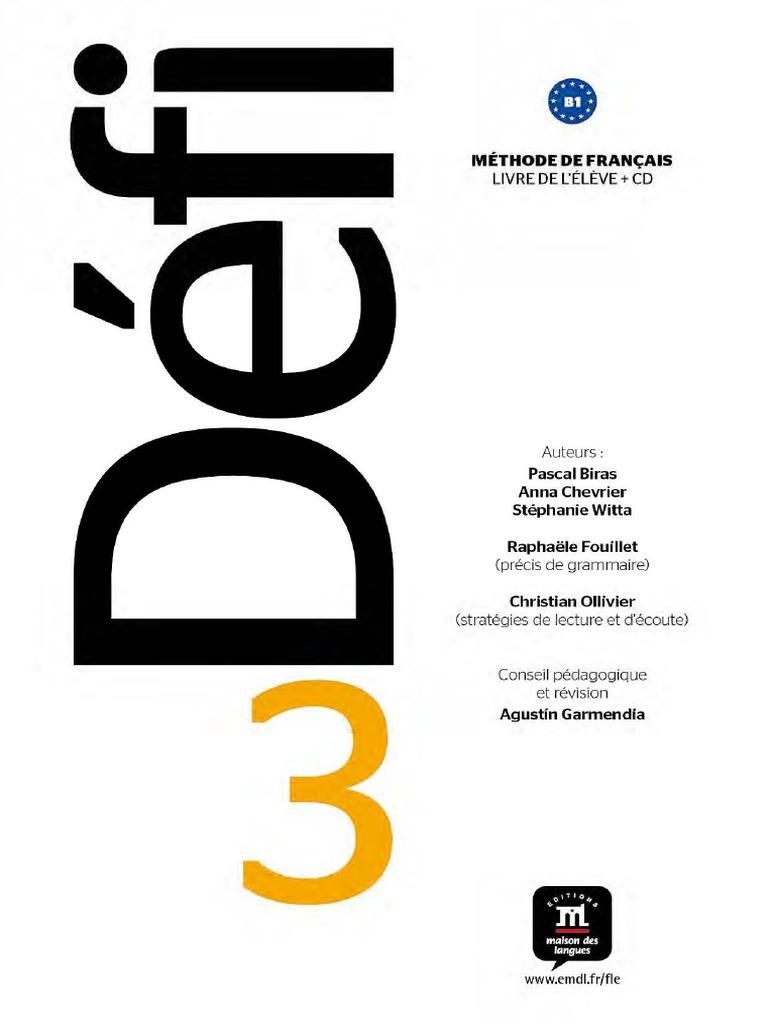
Despite some progress, “this book, which claims to be binding on the entire French school system, does not present the rigor or prudence that would be necessary to support this claim”. Pierre Sève, lecturer in French didactics, University of Clermont, analyzes the “Grammaire du français” that the ministry has just published under the authority of the Dgesco.
This is a book that meets a real need to update and stabilize terminology. From a formal point of view, it is not badly done: the terms introduced are recalled at the end of the presentations, under a heading "grammatical notions", in cartridges, there is an index... In detail, we can lament a number of points.
A non-operative work
This book is not operational, its perspective is purely descriptive, and this description is not oriented by the needs of students (and therefore teachers).
Some examples:
- We know that students rely heavily on semantics to identify functions, for example that of circumstantial complement. However, in the sentence given as an example Alice goes to Paris, the group in Paris is analyzed as an indirect object complement on page 16 and again on page 40, and we have to wait for page 93 (point 2.4 “To go further far") to find the expression "verb circumstantial complement" - in a particularly confusing passage which tries to distinguish the circumstantial complements of sentence, the circumstantial complements of verb and the circumstantial complements which belong to the predicate (but this notion of "predicate seems reviled) without having been recruited by the verb. In short, this difficulty – which is not only terminological – is not relieved by a terminological clarity that the book promises but does not completely deliver.
- Still on the subject of circumstantial complements – of sentences, in this case – class attendance shows that students are reluctant to travel, and often rightly so. However, this point is relegated to note 5 on page 17 (point 1.4). Yet this ruins the idea that it would be easy to rely on deletion or displacement tests to differentiate between verb and sentence circumstantials.
It is because the very important distinction between value in language and value in discourse, the distinction between epilinguistic intuition and metalinguistic reflection, a distinction which runs the risk of escaping the least skilful pupils, this distinction does not is not done. Moreover, it is necessary to wait for the detour of a “to go further” for it to be exposed, p. 106.
- In the presentation of the temporal values of verbal forms (present, past, future) (p. 143 et seq.), it is never said that they are to be understood from the point of view of a situated enunciation and that therefore the pupils are regularly in difficulty in front of a written text (precisely to build this present, this past or this future which are not theirs). This is a precaution that could have been taken at a lower cost.
- The semantic dimension is not really supported. Thus the expansions of the noun phrase are presented only in their determinative value – and again, this only in connection with the relative epithets (on page 59, point 1.4.1.) even though the relative does not appear in the list of LARP expansions as provided to us – and never in their qualifying value.
- Similarly, the distribution of the lexicon into hypernyms and hyponyms is presented on p. 175 (point 4.4.5) without ever explaining how this organization of the lexicon is useful (in the management of chains of lexical substitutes, in the interpretation of polysemic terms, for example).
- The presentation of the verbal morphology is not made to facilitate the memorization of the forms: if the analysis in marks of time-mode and marks of the person is well presented, the distinction of verbs in "verbs in - e” and “verbs in -s” is not made, and it is the analysis in “endings” which is put forward.

This book is not free of dark areas
- You have to be aware enough of the problem to follow the use of the negation test in the passage on page 93 already mentioned.
- Why is the relative epithet not presented as an expansion of the LARP? Why is this relegated to the presentation of the “epithet” function (page 59)?
- Why in "Before leaving the postman distributes the mail" the group "before leaving" is considered as a "prepositional infinitive group" (p. 195) while in "She speaks of succeeding" the group "of to succeed” is considered as an “infinitive” and not as a “prepositional infinitive group” (p. 198)? If we consider that the notion of preposition only applies to terms which introduce a circumstantial complement (there would be arguments for that), that prepositions which are linked to a verb are not really such, it should at least say so. But it is doubtful that this was the intention, since “de mon poste” in “She speaks of my postman” is indeed presented under the heading “prepositional noun phrase” (p. 194).
- in the presentation of subordinate clauses (p. 53), we do not see very well the reason for the heterogeneous criteria which lead to the list: “complete subordinate clauses; circumstantial subordinate clauses; relative subordinate clauses; subordinate clauses without a subordinating conjunction. There is a criterion linked to the function: complete / relative (epithet) / circumstantial. There is a morphological criterion: with a subordinating conjunction / without a subordinating conjunction.
But the set does not combine easily. Reading the list as presented, one might think that relative clauses are introduced by a subordinating conjunction (since they are not part of the "subordinates without subordinating conjunction"; one might also think that infinitives do not are not supplements... Should we see here a clumsiness, too hasty work, a refusal to enter into a certain complexity (a refusal contradicted by many other aspects of this work)?
With indulgence, we will say that the authors wanted to simplify a complex presentation, but we regret that they did not indicate the principles of this simplification.
We can also wonder why indirect partial interrogatives are not close to relatives, since they are close morphologically (introduced by a pronoun) and semantically (relating to a qualification or a determination of a referent – unknown in the case of the query, expressed by the antecedent in the case of the relative). It is necessary to wait for the “Latin lesson” on page 113 so that the comparison is suggested to be immediately rejected.
- The presentation of connotation actually presents differences in language registers, and not really connotations (it is true that the admission is made: "connotation introduces nuances in terms of language register , affectivity or shared cultural references.” Julia Kristeva will appreciate!
Given the marked lack of interest in this book for discursive dimensions, one wonders why the notion appears there. This is undoubtedly a concession to secondary school teachers who make a great deal of it in the study of literary texts.
This book takes sides that are not discussed
- It is asserted that "there is only one non-personal mode which is divided into three forms: the present participle, the past participle and the infinitive" (p. 151)... which leads to a formula, let's say risky: "they are distinguished only by their appearance". Is this not neglecting here the nominal dimension of the infinitive and the adjectival dimension of the participle?
- The traditional division of verbs into three groups, a division disputed by all didacticians (Chartrand, Gourdet, etc.), is repeated on p. 138 without discussion or justification. Moreover, we associate verbs whose inflectional behavior is not at all the same as savoir (verb with two bases: I know / we know) and perceive (verb with three bases: I see / we see / they perceive), such as flee (verb with a hiatus glide: I flee / we flee) and serve (verb with a consonant drop I serve / we serve)…
- It is decided (p. 86, point 2.3.1) that the complements of the verbs of measure (pesser, mesure, couter…) are considered as COD. One wonders why, since the two consistent arguments against it are given: the impossibility of putting in the passive a sentence like "the baby weighs four kilos", the difference in meaning from "The pediatrician weighs the baby" . Is it because of the agreement in formulas like “the efforts that the company cost me”? If this is the case, it is unfortunate that this reason is not made explicit.
- The exposition on iconicity (p. 134) seems flimsy when it asserts “iconicity is much more widespread than has long been believed”. This is a question that is still widely debated, and the reference to secondary teaching practices refers to stylistic considerations rather than linguistic knowledge.
This book has regrettable shortcomings
- There is only an allusion to the role of the tonic accent (p. 121) in connection with the possessive pronoun derived "from a form, called tonic, of the possessive determiner (mine, yours, his, etc.) .)” We regret this – not for these possessive determiners, which are rare and which are not mentioned anywhere else in this work – but because identifying the role of the tonic accent makes it possible to understand vowel alternations and shed light on many families of words (heart / courage, among others) and many conjugations (I can / we can).
- Nothing is said about presentative sentences (here / there you are, there is, it is…) which are nevertheless extremely frequent, especially in the language of the pupils. There is only a vague allusion to it, in the course of a "history of the language" insert, and only in connection with emphatic sentences with extraction, that is to say precisely in turns which are not presentative sentences (p. 79).
- the syntax of dont is never explained. Admittedly, it is complex, but the link with the particle de (sometimes preposition, sometimes element of the partitive determiner, sometimes simple copula) is not made, whereas it is made for the adverbial pronoun en.
This book contains genuine errors
- The traditional formula "the adjective expresses a quality or a property of the noun to which it relates" is taken as it stands although it is manifestly absurd. In "the red house" the adjective expresses a quality of THE THING evoked by the name, not a quality of the name itself! The word house is not here written in red.
- It is said (p. 35 and p. 138) that the verbs of the second group (finish type) are derived from the verbs of the fourth Latin conjugation (like audire -> ouïr, venue -> -> sleep, feel -> feel, serve -> serve…) None of the French verbs resulting from these verbs (the most frequent) of the fourth conjugation belongs to the second group.
Verbs of the finish type essentially come from verbs of the third conjugation, whose stem ended with the inchoactive suffix -esc- (such as durescere -> harden, emacescere -> maigrir, erubescere -> ; blush, groan --> groan, grandecere --> grow…)
- In “to go further” on page 155, the formula “go ascending” is considered a gerund without a preposition. This is to misunderstand the progressive form of French constructed with the semi-auxiliary to go and the present participle: “Lors vous n’avoir servante oyant tel nouvelle / Qui au noise de Ronsard ne s’aille waking up. (Ronsard). Moreover, for this example, there is no reformulation with the preposition, unlike the other examples given (cash = counting the money…)
Finally, this book does not avoid cunning
There is an overabundance of “Latin lessons” that do not enlighten anything.
Certainly, it is not useless to justify the importance in French of the place of words as opposed to the freedom of Latin (finally to explain the difference between languages with declension and the others) or to identify remanences of declension in the behavior of pronouns, certainly it would have been useful (on page 62, for example) to compare the subject to the accusative of the infinitives in French (“I see them playing”) and in Latin ( “eos ludere jubeo” “I wish they would play”), but what is the point of comparing (p. 61) the relative subjunctive of French and Latin since they are similar? To know the way in which the Latins introduced indirect interrogatives since this way disappeared without a trace (p. 56)? To know the construction of the verbs of will in Latin since it has no relation with the construction in French of the same verbs (p. 56)? To follow the disappearance of quis in favor of qualis in the Latin of the 4th century (p. 113)? etc., etc.
This cunning is all the more visible since the history – for example – of subordinating conjunctions is not explained. Now it would have been useful, for example, to explain how que was used for almost all subordinate clauses in medieval French; that it was in Middle French (15th / 16th centuries) that they were differentiated so that; then + that; by + this + that; then + than; at + when + that; to + end + that…; that some have agglutinated but not all, but that this universal use of que has been maintained in popular language, that of many students (“I work, I work, that I have aches.” “ I work, that you have to earn your money” “The toy that I want”…)
All in all, this book, which claims to impose itself on the entire French school system, does not present either the rigor or the prudence that would be necessary to support this claim. However, we will not shy away from the profitable advances it offers: recognition of substantive relatives whose antecedent is a this or a that; clear presentation of the semi-auxiliaries (go, come from, begin at, finish from…+ infinitive), among others…
Pierre Sève
MCF in French didactics, Clermont-Auvergne University
French grammar, Dgesco
Pierre Séve: From instruction without education







